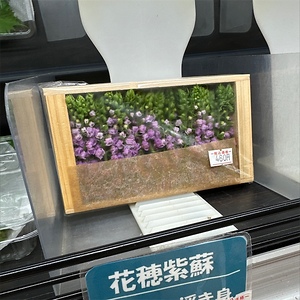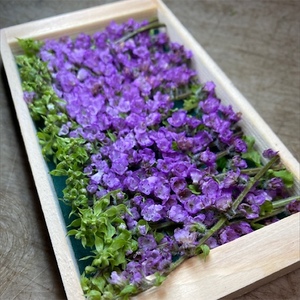


Hanaho Flowers
Estimated Inventory, ea : 0
This item was last sold on : 07/10/25
Description/Taste
Hanaho flowers grow along upright stalks at the top of a busy plant with broad and toothed, dark green to purple leaves. The flowers are small, generally harvested in sprigs averaging 8 to 10 centimeters in length, and are comprised of curved, oval to tapered petals surrounding an open center. Hanaho flowers range in color from bright purple to white, and the petals are delicate, soft, pliable, and crisp. The blooms release a distinct, sweet, and herbal aroma, often likened to mint, and have a fresh, sweet, and vegetal, peppery flavor. Hanaho flowers are milder than shiso leaves, and each bloom color will have a slightly different taste. Purple Hanaho flowers are said to have an anise-like flavor with cinnamon, ginger, and cumin notes. White Hanaho flowers have a brighter taste with mint, basil, fennel, and green nuances.
Seasons/Availability
Hanaho flowers are available year-round, with a peak season in the summer through fall.
Current Facts
Hanaho flowers, botanically classified as Perilla frutescens var. crispa, are aromatic blooms of the shiso plant belonging to the Lamiaceae family. Shiso is native to Asia, and almost the entire plant is incorporated into culinary preparations, including the leaves and flowers. Hanaho flowers grow on herbaceous, bushy plants reaching 45 to 60 centimeters in height and are one of the most popular edible flowers in Japan. The flowers can be white or purple, depending on variety, and are sometimes known as Perilla flowers, Shiso flowers, Hojiso, or Hana Hojiso, a descriptor used for when the flowers are still attached to the stalk. Hanaho flowers are typically served when they are young and fresh, plated as an edible garnish to enhance the dining experience. More mature flowers can be lightly cooked or fried for main dishes and appetizers.
Nutritional Value
Hanaho flowers have not been studied for their nutritional properties. Edible flowers, in general, have been known to contain vitamin C to strengthen the immune system, potassium to balance fluid levels within the body, and calcium to build strong bones and teeth. The blooms also provide vitamin A to maintain healthy organ functioning, antioxidants to reduce inflammation, and other nutrients, including phosphorus, iron, niacin, and riboflavin.
Applications
Hanaho flowers have an herbal, sweet, warm, and bright flavor well suited as a garnish over fresh and cooked preparations. The flowers are traditionally served raw and are stripped from the stalks and sprinkled into soy sauce, vinegar, dressings, and sauces, scattered over salads, grain bowls, soups, and yogurt, or topped over roasted meats, vegetables, and other main dishes. Hanaho flowers can also be left on their stalks and served as a centerpiece on main dishes. The flowers compliment sweet and savory preparations, and they are popularly rolled into spring rolls, sprinkled over side dishes, stirred into pasta, or sauteed with shiso leaves and served with meat, seafood, or tofu. In Japan, Hanaho flowers are incorporated into chazuke, a cooked rice mixture combined with green tea and toppings such as pickles, seaweed, scallions, or fish. The flowers are also fried into tempura or pickled for extended use as a condiment. In addition to savory preparations in Japan, Hanaho flowers are sometimes used to brighten flavors in desserts and are displayed as a fragrant, visually attractive bloom. Beyond culinary dishes, Hanaho flowers are increasing in popularity as an edible garnish in cocktails. Hanaho flowers pair well with citrus, pears, plums, apples, and melons, aromatics including garlic, scallions, ginger, and onion, grilled meats such as poultry, pork, and beef, and seafood including fish, crab, sea urchin, and shrimp. Whole, unwashed Hanaho flowers should be immediately consumed for the best quality and flavor. The flowers will also keep for a couple of days when stored in a ventilated container in the refrigerator’s crisper drawer.
Ethnic/Cultural Info
Hanaho flowers are a traditional garnish for sashimi. The word sashimi translates from Japanese to mean “pierced body,” a descriptor thought to be derived from ikejime, a practice of killing fish by piercing their brain. This method prevents lactic acid from building in the fish’s body, helping to preserve the freshness of the meat for culinary preparations. Ikejime is often used when catching fish for sashimi, tying the two together in just one of several theories discussed among historians. The origins of sashimi are mostly unknown, but the fresh fish dish was traditionally served in the coastal regions of Japan. Sashimi became popular during the Edo period, spanning from 1600 to 1867, and with its rise in popularity came the growth of edible garnishes to enhance the experience of eating raw fish. Hanaho flowers are customarily served on the stalk in small cuttings and are elegantly placed beside or on top of the fish. The fragrant blooms add color, aroma, texture, flavor, and visual appeal to the dish, satisfying the senses to create a memorable dining experience. Some consumers choose to scrape the flowers from the stalk and allow them to scatter over the dish. The flower petals are also stirred into soy sauce as a colorful dipping liquid. Along with the flowers, shiso leaves are favored for their aromatic nature and distinct flavor, complementing the refreshing and mild flavors of the raw fish. They are used as wraps, plate decorations, and as a flavoring in salads.
Geography/History
Hanaho flowers are native to the mountainous regions of eastern Asia and have been growing since ancient times. The flowers were mostly a secondary crop, used in conjunction with the more popular shiso leaves, but as the plants became a widespread culinary herb throughout Asia, the flowers were also integrated as a fresh, edible garnish. Hanaho flowers were introduced to Japan between the 8th and 9th centuries and were spread to Europe, western Asia, and the New World via trade routes in the 1800s. Today Hanaho flowers are a favored edible bloom throughout Asia and are cultivated and sold as a specialty flower in the United States and Europe. The flowers can also be harvested from home gardens and wild plants, offered seasonally through farmer’s markets.
Featured Restaurants
Restaurants currently purchasing this product as an ingredient for their menu.
| Sushi Gaga | San Diego CA | 619-808-1556 |
| Jeune Et Jolie | Carlsbad CA | 858-231-0862 |
| Javier Plascencia (Animalon) | Bonita CA | 619-295-3172 |
| Addison Del Mar | Del Mar CA | 858-350-7600 |
| Lilo | Carlsbad CA | 619-385-0914 |
Recipe Ideas
Recipes that include Hanaho Flowers. One
| Recipes for Tom |
|
Japanese cucumber and perilla flowers in sweetened rice vinegar |
| Recipes for Tom |
|
Warm tofu topped with saute-simmered perilla flowers and young dried sardines in broth |










